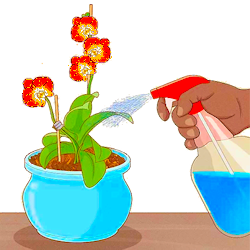
There are many different ways one may water orchids and grow them successfully. Some drench the medium with a water breaker from above, some submerge the pot of an extended soak, while others “spritz” the medium to wet it, as depicted above. Some wait for the medium to dry out before watering, while others (like me) stick to the opposite end of the “watering spectrum” by keeping the potting medium constantly wet.
They all can work and each technique has its own related requirements. Which is “the best” is where the philosophy comes in, and that is a decision each grower must make for him- or herself.
The first thing one must do is decide what you’re looking for in your orchid-growing. Is your interest “keeping them alive” with the occasional blooming period, or is it “growing them to specimen size with lots of blossoms”, or somewhere in between?
Let’s pause to consider a bit of science on this subject. Water is the driving force for growth. For any plant to add one pound of mass, its chemical processes will consume only about 5 grams (a teaspoon) of fertilizer, but they require 200 pounds (25 gallons/95 liters) of water. Add to that the fact that a plant can lose up to 95% of its absorbed water to transpiration, and that means the plant must actually absorb as much as 4000 pounds (500 gallons, or about 1900 liters) of water.
Armed with that bit of data, you can see that, to get the most out of your plants, a copious and continuous water supply has distinct advantages over the “water when dry” strategy. However, keep in mind that you cannot simply start watering more to get better growth, as there are two things to consider – the potting medium and the roots themselves.
If you’re going to water heavily and often, or use a potting medium that holds water for a long time, it is important that it have more, large, void spaces, so they’ll stay open and airy even when saturated (see “Water Does Not Cause Root Rot“). That’s easy enough to do, but is only half the “equation”, as the existing roots will likely not be optimized to handle being constantly moist (see our Transplant “Adaptation” article).
If you have decided to be a “proactive” grower, rather than more of a “maintenance” type, you should lay out a conversion strategy:
- Consider they types of media components out there that are easily accessible, and their water-holding and aeration properties.
- Talk to other growers and get their assessments, keeping in mind their growing conditions and how they may differ from yours.
- Once you have decided upon a reasonable medium candidate, move a single plant over to it, being sure to time the move to coincide with the emergence of new root growth, so those will grow optimized for the new conditions.
- Give it several months of evaluation before moving other plants over, possibly even “fine tuning” things to better suit the plants in your environment.
